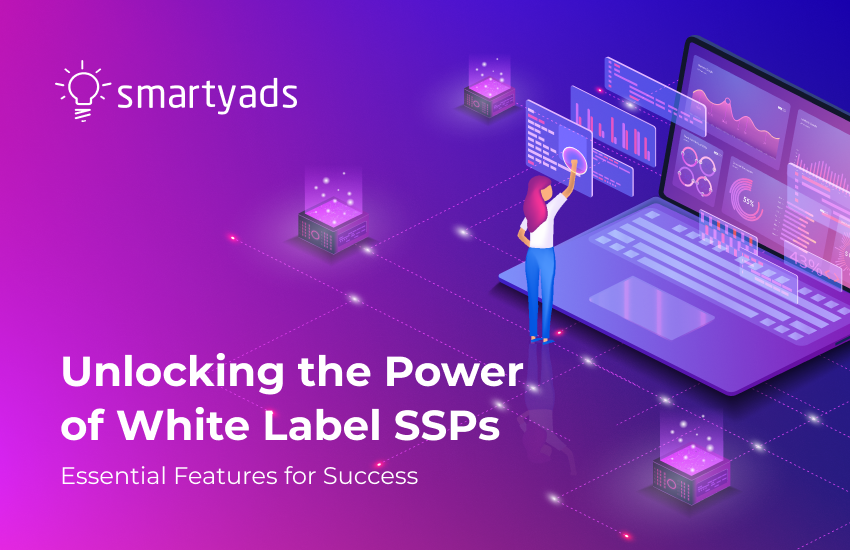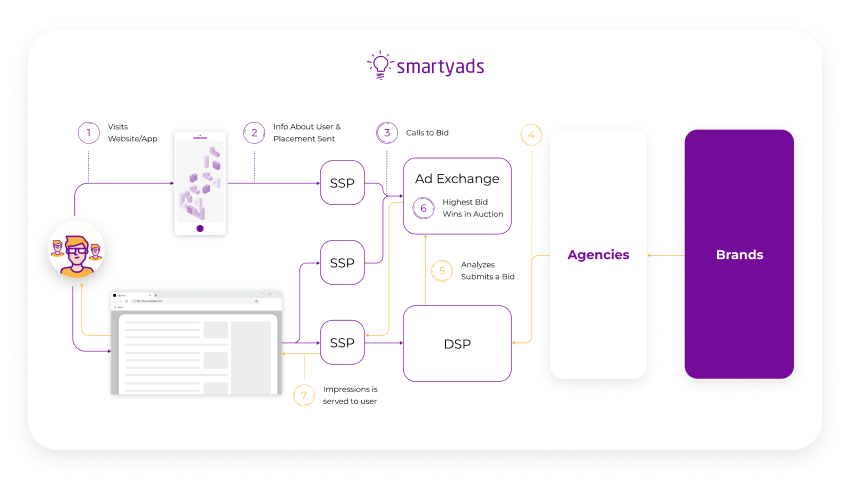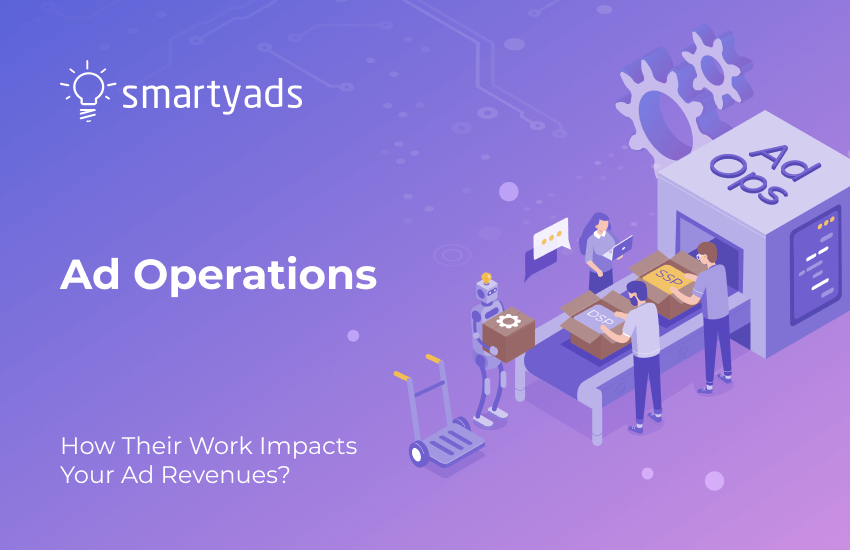In the rapidly evolving digital advertising industry, publishers always seek new ways to maximize revenue streams. One way to achieve this is through white-label supply-side platforms (SSPs), which provide publishers with the tools they need to manage and monetize their ad inventory effectively.
White-label SSPs are a type of technology that allows publishers to customize and brand their adtech platform to match their unique needs and preferences while still benefiting from the features and functionality of an established SSP provider.
However, it's essential for publishers to carefully evaluate the features and capabilities of potential solutions before making a choice. In this article, we'll explore the essential features that publishers should look for when selecting a white-label SSP to ensure success in maximizing their ad revenue.
What are white-label SSPs, and why are they different from regular SSPs?
A supply-side platform (SSP) is a technology platform that allows publishers to manage and sell their ad inventory to advertisers. SSPs connect publishers with multiple demand-side platforms (DSPs), ad exchanges, and other buyers in real-time, allowing them to sell their ad inventory to the highest bidder. In contrast, white-label SSPs are a technology that allows publishers to customize and brand their adtech platform to match their unique needs and preferences.
The key difference between regular SSPs and white-label SSPs is the level of customization and branding available to the publisher. With a regular SSP, the publisher is limited to the features and branding provided by the SSP provider. In contrast, a white-label SSP allows the publisher to fully customize and brand the platform with their logo, color scheme, and other design elements. This level of customization not only provides a more seamless user experience for the publisher's team but also helps to reinforce the publisher's brand identity with their advertising partners.
Another significant advantage of white-label SSPs is that they can be more cost-effective than regular SSPs. White-label SSPs often provide publishers with more adaptable pricing options, enabling them to pay solely for the features they require, as opposed to a predetermined package that may encompass functionalities that aren't pertinent to their particular needs. Additionally, white-label SSPs often require less development time and resources than building a custom adtech platform from scratch, making them a more accessible option for smaller publishers who may not have the technical expertise or budget to develop their adtech solution.
Why do you need white-label SSP as a publisher?
Many publishers wonder if they should use a white-label solution when regular SSP platforms exist. Of course, it may be that such a solution isn't suitable for you and that a regular SSP or a self-service SSP is ideal for your brand. But let's take a look at the benefits that a white-label SSP can offer you as a publisher.
- Customization
White-label SSPs allow you to customize and brand the platform to match your unique needs and preferences. The benefits of a highly customizable advertising platform are clear. By investing in a solution that can be tailored to your exact needs, you can improve the efficiency and effectiveness of your team, build a stronger brand identity, and forge deeper connections with your advertising partners. It also allows publishers to request any specific to their business features or integrations as custom development.
Control
With a white-label SSP, you have greater control over your ad inventory and the bidding process. You can set your floor prices, manage your rules and preferences, and choose which advertisers and DSPs you want to work with.
Revenue Maximization
Using a white-label SSP, you can tap into multiple demand sources, including DSPs and ad exchanges, to help you maximize your revenue potential. Additionally, white-label SSPs often offer advanced targeting and optimization tools that can help you increase the value of your ad inventory and improve the relevance of your ads displayed to your audience.
- Cost-Effectiveness
White-label SSPs can be more cost-effective than building a custom adtech platform from scratch or using a regular SSP. With white-label SSPs, you typically pay only for the features you need rather than paying for a standard package that may include features that are not relevant to your specific needs. Additionally, white-label SSPs often require less development time and resources than building a custom adtech solution, making them a more accessible option for smaller publishers.
The white-label platform is not a panacea and a perfect solution to all problems of any brand. However, it can provide a number of advantages not available with a standard SSP platform. Consider these advantages carefully; perhaps they are critical to you.

What features to look for in white-label SSP?
Not all white-label SSPs are created equal, and it's important to carefully consider your unique needs, your visitors' preferences, and your web source or app when selecting the right media-selling technology. While there are numerous ways to monetize website traffic, advertising can often generate the most significant revenue, particularly when traffic is consistent and substantial.
While some white-label SSPs have no minimum traffic thresholds, others require publishers to meet specific criteria before serving online ads. Once you confirm that you meet the requirements to become a publisher with a particular white-label SSP, you must look for specific features and characteristics that can help you optimize your ad revenue.
- Customization Options
Look for a white-label SSP that offers a high degree of customization, allowing you to fully brand the platform with your logo and color scheme, as well as customize specific features, integrations, and logic that your business requires. The platform should also be flexible enough to accommodate your business needs and preferences.
- Real-time Bidding (RTB)
Real-time bidding is an essential feature for any SSP, allowing you to sell your ad inventory to the highest bidder in real time. Make sure the white-label SSP you choose supports RTB and can connect you with multiple demand sources, including DSPs, ad exchanges, ad-networks and even SSPs
- Ad Quality Control
Ad quality is critical for maintaining a positive user experience and protecting your brand reputation. Look for a white-label SSP that offers robust ad quality controls, including the ability to block certain types of ads or advertisers.
Reporting and Analytics
A good white-label SSP should provide detailed reporting and analytics to help you track your ad performance and make informed decisions about your inventory. Look for a platform that offers real-time reporting, detailed audience insights, and the ability to customize your reporting dashboard to suit your needs.
- Targeting and Optimization
Advanced targeting and optimization tools offer a range of benefits to businesses, including improving the relevance of ads displayed to their audience and maximizing the value of their ad inventory. These tools enable businesses to gain deeper insights into their target audience, optimize their ad campaigns, and ultimately increase revenue. Look for a white-label SSP that offers audience targeting based on factors such as geography, demographics, and user behavior, as well as advanced optimization features such as dynamic ad insertion and frequency capping.
- Support and Training
Ensure the white-label SSP provides excellent customer support and training resources to help you get the most out of the platform. Look for a provider that offers responsive customer support, comprehensive training materials, and ongoing updates and enhancements to the platform.
- Ad Format Support
Look for a white-label SSP that supports various ad formats, including display ads, video ads, native ads, and more. This will allow you to sell a variety of ad formats to your advertisers and maximize your revenue potential.
- Header Bidding
Header bidding is an advanced ad-selling technique that allows publishers to offer their inventory to multiple demand sources simultaneously, including ad exchanges and SSPs. Look for a white-label SSP that supports header bidding and can help optimize your bidding strategy to maximize your revenue.
- Integration with Ad Servers
If you already use an ad server, such as Google Ad Manager, look for a white-label SSP that can integrate seamlessly with your existing adtech stack. This will help you streamline your operations and avoid unnecessary complexity.
- Scalability
As your business grows, your adtech needs will evolve. Look for a white-label SSP that can scale with your business, providing the features and functionality you need to succeed, regardless of your size or industry.
- Fraud Detection
Ad fraud is a significant problem in the digital advertising industry, leading to wasted ad spend and a poor user experience. Look for a white-label SSP that offers robust fraud detection and prevention tools, including ad verification and bot detection.
- Support for Multiple Languages
If you operate in multiple regions or serve a diverse audience, look for a white-label SSP that supports multiple languages. This will allow you to provide a localized user experience for your team and advertisers, improving engagement and revenue potential.
Here are a few more important tips before you choose "the one" white-label SSP
Try a demo version. To see if the performance of a platform will be right for you, you can talk through your concerns with the vendor or try out a demo version of the platform. Such a feature lets you see firsthand how the platform works and whether it will meet your quality and usability needs. Delete “and whether it will have problems with low fill rates, poor ad quality, or slow load times.”
Check the flexibility of the platform. The platform should be able to change not only in terms of scaling but also because of the change in your business theme. If, at some point, you decide to change the vertical you're in or change your market sector, the platform should be able to adapt quickly to your brand's new needs. This may seem like a minor advantage, but you'd be surprised how often online resources change direction.
See how quickly a vendor integrates new features. The programmatic advertising industry is never static; something is constantly changing. Therefore, for any platform connected with such advertising, it is vitally important to react quickly to any changes and consider the most prospective novelties. Ask your potential vendor what recent innovations they've added to the white-label platform and how they could benefit publishers. The normal frequency of such updates is once every six months or more.
Bottom line
In conclusion, white-label SSPs offer a variety of benefits for publishers and advertisers looking to optimize their programmatic advertising efforts. By providing the flexibility to customize and brand the platform, white-label SSPs allow companies to differentiate themselves in a crowded market and build brand equity. Moreover, the advanced features offered by these platforms, such as real-time bidding, audience targeting, and data analytics, can help publishers and advertisers better understand their audiences and achieve greater returns on investment.
To succeed with white-label SSPs, it is important to choose a provider that offers the essential features and capabilities necessary for success. These include a robust ad server, a user-friendly interface, access to a wide range of demand sources, and powerful data analytics tools. By partnering with the right white-label SSP provider and leveraging these key features, publishers and advertisers can unlock the full potential of programmatic advertising and achieve their marketing goals.
If you've realized that white-label SSP is perfect for you, then be sure to check our platform.






